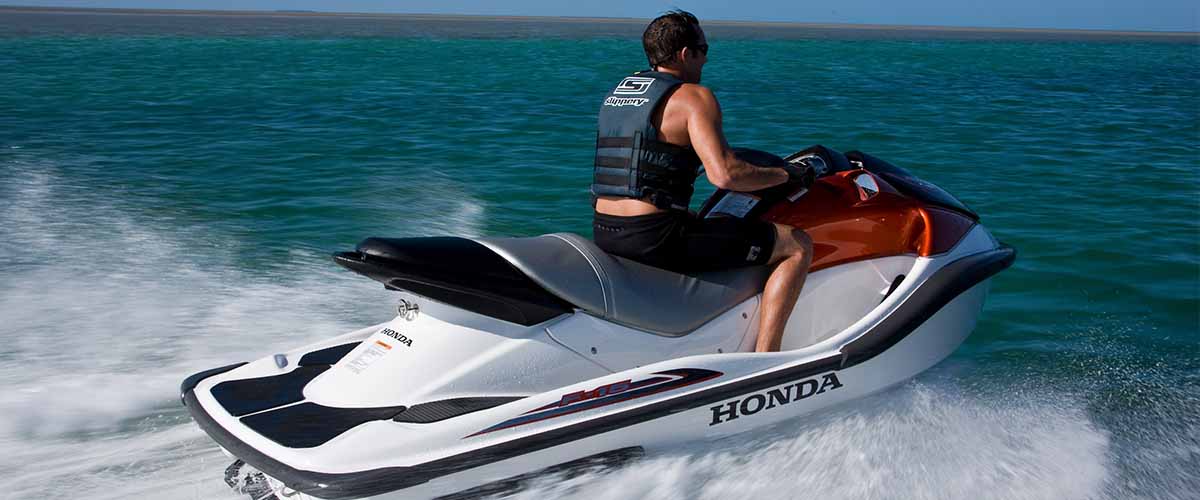Can You Beach a Jet Ski Without Damaging It? [Video]
Many riders beach their jet skis to socialize, swim, or picnic.
That’s why you see a lot of beached jet skis sitting on the sand wherever docks are not available.
But just because many do it, that doesn’t mean beaching is good for jet skis!
If you are wondering what the risks of beaching are, and what you should do instead, this post is for you.
Is it Okay to Beach a Jet Ski?
As a rule of thumb, it’s not recommended to beach a jet ski as it may end in several damages. Sand and rocks can scratch the hull or be drawn into the pump, which can result in impeller damage. Moreover, high tide or a big wave can lift the jet ski and accidentally carry it off. Because of these risks, some manufacturers don’t recommend beaching jet skis at all, while others recommend it only under certain conditions.
Are you wondering what these conditions are and how to avoid damages when beaching a jet ski?
Before we drill into the details, we have to explain that there are three ways to safely park your jet ski.
How Do You Beach a Jet Ski?
In general, you can beach a jet ski in three different ways. The most popular solution is probably to run the jet ski onto the beach. Although this seems to be the most convenient and stylish way, it is certainly NOT recommended! Instead, you must stop the engine when the jet ski is in water 3 feet deep and move it onto the beach by hand.
But as you will see, pulling the jet ski onto the beach is never a good idea as it holds many risks. Instead, the best practice is to properly anchor your jet ski close to the beach. This is always the best and safest alternative to beaching a jet ski!
Let’s take a closer look at the pros and cons of each practice:
Running a Jet Ski onto the Beach
Sadly, many riders beach their jet skis by simply running them onto the beach.
Although this is arguably the most convenient and stylish way to arrive at the beach, beware that it can damage the jet ski in many ways. The pump can suck up objects or seaweed from the bottom, and the jet ski’s hull can also be damaged.
That’s why every manufacturer recommends that you not run the jet ski onto the beach! Because of this, never beach your jet ski in this manner, even if the shore is covered with soft sand!
This video vividly shows what you should never do with your jet ski:
Pulling a Jet Ski onto the Beach by Hand
Another common solution is to shut off the jet ski’s engine close to the beach where the water is 3 feet deep and move the jet ski onto the sand by hand.
This is considered a much safer way to beach a jet ski, which is why some manufacturers recommend parking your jet ski in this way.
But don’t forget that even if this solution is less harmful for the jet ski, it is still not the safest way to reach the beach.
Here’s what you should do instead.
Consider Anchoring Instead of Beaching
Best practice is to always stop the engine and anchor your jet ski at the safest distance from the beach.
As the hull doesn’t even touch the bottom, anchoring is considered to be the safest way to park a jet ski if there is no dock nearby.
This is the reason why many professionals as well as the majority of boat and PWC manufacturers recommend anchoring rather than beaching!
If you are determined to beach your jet ski, don’t hesitate to read more. You can learn what the potential risks are of beaching your jet ski, and how to try and avoid them.
The Risks of Beaching a Jet Ski
Is it Legal to Beach a Jet Ski?
Contrary to popular belief, beaching a jet ski is illegal in some places! Always check the local laws to stay legal.
Objects Get Sucked Up
The main risk of running your jet ski out of the water is that the pump can suck up objects like rocks, debris, or seaweed from the bottom in the shallow water.
These items can damage the impeller or the wear ring or clog the hoses of the exhaust or the cooling system.
Because of this, you must always turn the engine off when the water is less than 3 feet deep!
Hull Damage
If you run your jet ski onto the beach or just pull it by hand, stones can easily scratch the bottom of the hull.
Even straight sand can damage the paint job over time, as it’s quite similar to wet sanding!
Beyond the hull, the intake grate and the ride plate also can also be damaged if you run your jet ski on a stone, as these parts are located on the bottom of the jet ski.
Sand in the Pump
When you ride or pull your jet ski onto the beach, sand and small rocks can easily get into the pump.
Moreover, while the jet ski sits on the beach, the waves continuously splash them into the pump.
If you start the engine, these can cause a jam, damage the impeller, and wear ring, or even get into the cooling and exhaust systems.
Tide and Waves
Another drawback of beaching is that the incoming tide or a big wave can easily carry your jet ski off.
Also, waves are continuously splashing and moving the jet ski around on the sand, which may result in more damage to the bottom of the hull.
But at least you wouldn’t have to worry about your jet ski getting stuck on the beach because of the falling tide. It’s because unlike stranded boats jet skis can easily be moved back into the water by hand.
Tips for Beaching a Jet Ski
As you can see, there are many ways that your jet ski can be damaged on the beach.
But if you are still considering beaching your jet ski instead of anchoring it, here are some tips to reduce the risk of damaging it:
- Know the laws to stay legal, as beaching is not allowed in some areas.
- Safety first. Before you head to the beach, make sure that there are no swimmers or other vessels in the area.
- Reduce your speed at least 400-500 feet before you reach the beach.
- Always shut off the engine if the water is 3 feet deep (waist deep) and wait until the jet ski stops.
- Move it by hand. The best practice is anchoring the jet ski, but if you want to chance beaching it, move it onto the beach by hand. You may want to act slowly, as rushing can do more harm than good. NEVER run the jet ski onto the beach using the engine power or the force of momentum!
- Check the bottom carefully to avoid pulling your jet ski over a rock, shell, stick or other debris. The best places to beach a jet ski are on sandbars but beware that the above-mentioned objects can even be found in the sand!
- Secure it. If you leave your jet ski unattended on the beach (which is not recommended) make sure that you secure it to a stationary object or a screw anchor.
- After beaching the jet ski, pull the jet ski deep into the water by hand. Never use the braking system to force the jet ski back to the water!
- Before you start the engine, you may want to clean the pump to remove sand and rocks from it. To do this, rock the jet ski side-to-side in the water and firmly push down its rear side several times.
- Start the engine just after you’ve cleaned the pump and where the water is at least 3 feet deep.
Also, keep in mind that no two beaches are the same.
Even if you beached your jet ski many times in your local area, this doesn’t mean you can’t get in trouble on another beach.
To avoid any problems, always act slowly and check the bottom of the water carefully!
Advantages of Beaching a Jet Ski
As you can see, beaching can damage a jet ski in many ways. Are you still wondering why this is so popular?
After the cons let see the pros of beaching jet ski in a nutshell:
- Much easier, quicker and requires less effort than anchoring
- No anchor needed
- You can hear the sound system
- You can reach the gear in your jet ski much easier
- Your jet ski won’t sink if water leaks into its hull somewhere
- Beaching makes sense in cold weather, as not everybody wants to jump into waist-deep cold water.
- Another issue could be that if the water suddenly deepens, this makes it difficult to anchor the jet ski.
- If you are camping it is also recommended that you pull the jet ski onto the beach for overnight and to properly secure it.
Conclusion – Is It Bad to Beach a Jet Ski?
The short answer is yes, beaching is bad for jet skis as sand and rocks can scratch the bottom of the hull, or can damage the impeller, wear ring, or the cooling system.
How do you park a jet ski on the beach? As a rule of thumb, there are 3 different ways to park a jet ski if docks are not available:
- Running it onto the beach, which is definitely NOT recommended
- Pulling it onto the beach by hand – much better, but still not the best solution
- Anchoring the jet ski instead of beaching – this is the best practice for parking a jet ski on the beach
If you still want to beach your jet ski instead of anchoring it, beware of the potential damage it could cause, like:
- Scratches on the bottom of the hull
- Stuck impeller due to debris or rocks
- Damages on the impeller and wear ring
- Clogged and damaged cooling and exhaust system
- Tides and waves may carry your jet ski off
- Legal problems
Because of these concerns, beaching a jet ski is not recommended at all. Best practice is to shut the engine off where the water is 3 feet deep, and to properly anchor your jet ski!
References:
https://www.boatus.com/magazine/trailering/2013/june/how-to-beach-your-boat-and-leave-again.asp
https://www.anchoring.com/blogs/anchoring/shore-anchoring-or-beaching-your-boat
DISCOVER 2024 PWC MODELS Kawasaki, Sea-Doo, Yamaha, Krash…





